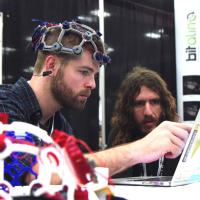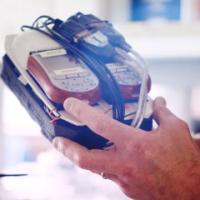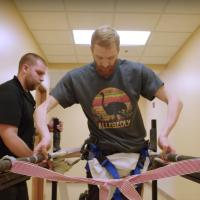Georgia Tech researchers Thad Starner and Caitlyn Seim have developed a pair of gloves for playing piano that can magically get you up to speed in just an hour. They’ve also taught blind people to read braille in four hours, a process that usually takes up to four months. The gloves work through a process called passive haptic learning, and is another great discovery from Georgia Tech researchers.
Basically, they vibrate in ways that stimulate the correct movement in the user’s hands. While the applications have been impressive so far, Thad and Caitlyn believe we’re just scratching the surface. Most recently, they’re exploring how the gloves can be used to restore movement in people that have suffered traumatic brain injuries. And the results are very promising.
As one of the first people to use a wearable computer, Thad Starner has been a pioneer in wearable technology for decades.
Most people would recognize his work with Google’s Project Glass, where he works as a Technical Lead and Manager, but one of the Georgia Tech professor’s most recent wearables—gloves for playing piano—turns technology into a teaching tool via what they call passive haptic learning.
The secret is specialized vibrations that help the brain soak up knowledge even if the wearer isn’t paying attention. This has enabled Starner and his team to teach people how to play the piano in less than an hour and read braille in just a few hours. This technology is another advancement furthering the musical capabilities of humans.
But beyond the usefulness of picking up an additional skill or hobby, researchers are asking bigger questions: can the same technology that helps you passively learn also help you recover from a traumatic brain injury?
For people like Alex, who lost most of the movement and sensation in his right hand after a stroke, being independent all starts with the hands.
All the things we take for granted, like bathing, dressing, and eating, require highly specialized movements—movements that are only noticed when they’re difficult or impossible to perform. Add to that the frustration of dependency (on health care professionals, friends, family, and even strangers), and it can all take a psychological and mental toll beyond the physical limitations.
Like the fictional character of Neo in The Matrix (Keanu Reeves), who spends just seconds learning different languages and martial arts skills, Starner and Seim hope to bring this quick-learning process to the real world with their special gloves.
But these gloves for playing piano don’t require you to actively study or work at it. Instead, while you go about your day, electronic impulses vibrate the same pattern that corresponds to a piano melody, reinforcing a learning process that happens entirely in the background. When the glove comes off an hour later, people who have never played the piano can confidently peck out a simple melody without even thinking.
Even when researchers challenged test subjects with simultaneous SAT or GRE questions, or upped the ante with more complicated two-handed pieces (like Mozart’s Turkish March), the information seemed embedded in their participants’ minds, and could be performed on demand.
That led Seim to think about other applications of this magical technology beyond gloves for playing piano.
Upon discovering that only 10% of blind people can read braille—a literary crisis according to the National Federation of the Blind—Starner and Seim shifted their attention to the difficulties in learning braille, which typically takes about four months.
With a two-glove system that taught participants how to type braille, they were able to learn 94% of the braille alphabet in just four hours.
But all their tests thus far were limited to those with full motor control of their hands. The next step, so it seemed, was to determine whether passive, quick learning could help patients with spinal cord injuries increase their existing mobility and function.
It did. And after an eight-week teaching period with the gloves, the researchers noticed a marked improvement in sensation and ability across several patients.
When Seim brought the gloves to stroke victim Alex, who would wear them for about three hours a day during normal, routine activities, the researchers started to notice something amazing: function that had long been thought of as lost started to return, as did increased feeling.
But Seim and Starner aren’t done yet. They’re still looking for ways to solve problems with technology, and whether it’s with gloves that help you play piano, learn braille, or help spinal cord and stroke victims increase their self-reliance and bodily ability, we can’t wait to see what they do next.
For more interesting news about the issues and topics that drive our world, keep it right here on Freethink. We’re Freethink Media, and we move the world, one story at a time.


